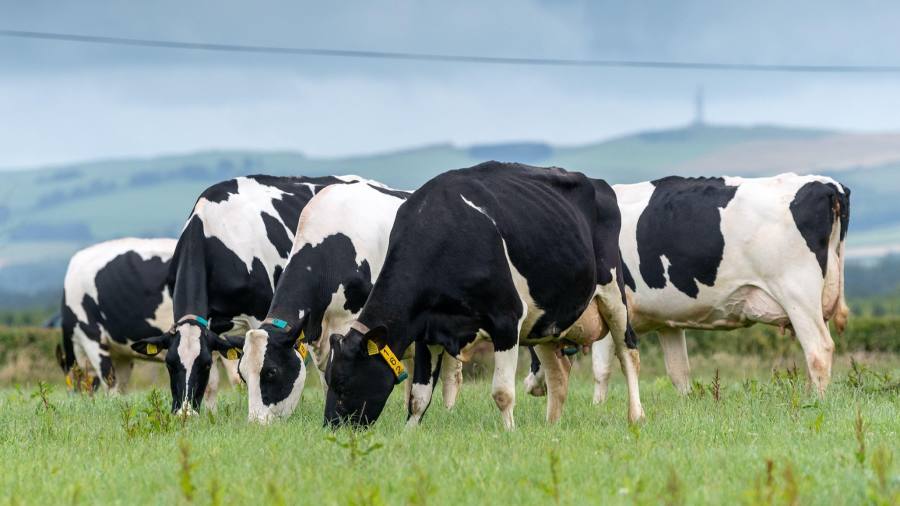Receive free Food Prices updates
We’ll send you a myFT Daily Digest email rounding up the latest Food Prices news every morning.
The amount that most UK farmers are paid for milk has plunged below their production costs, exacerbating concerns over the viability of small dairy farms.
Arla and Muller, Britain’s two largest dairy processors, cut their “farmgate price” for five consecutive months, with Arla holding the price at 35p a litre in June and July, down 29 per cent from 49p in February. Muller pays 38p a litre compared with 47p five months ago.
The fall in the amount paid by dairy processors, intermediaries between farms and retailers, is a result of a global oversupply and drop in demand for dairy, as well as the global downward trend in the market price of agricultural commodities, which consumers have yet to see reflected on supermarket shelves.
But farmers and industry bodies warned that the sustained drop was compounding an already difficult business climate and that customers would have to pay more for milk if farmers were to break even.
“We’re at the mercy of markets,” said Chris Wood, a dairy farmer near Penrith, Cumbria, who supplies Arla. “Everybody is on about food inflation but we’ve got inflation too. We’ve got to live.”
The government is increasingly concerned about the high rate of food price inflation, which stood at 18.3 per cent in May. The Treasury announced on Wednesday that it would scrutinise the profits of companies in the food industry supply chain.
Amid widespread price rises, milk is one of the few staples showing signs of deflation, raising hopes that consumers will soon benefit from plummeting commodity prices.
In April, the average cost of one pint of milk fell by 2p to 68p, according to the Office for National Statistics, the first decline since Russia’s full-scale invasion of Ukraine in February last year led prices to soar. The price remained unchanged in May.
Andrew Opie, director of food and sustainability at the British Retail Consortium, a trade body, said milk’s short supply chain meant lower energy and commodity costs could be passed on more quickly to shoppers than for products made with multiple ingredients or requiring manufacturing.
But marginally cheaper milk in shops is no consolation for farmers, who are contending with the cut in income from dairy processors as well as historically high input prices.
Wood said that while his fertiliser prices had halved, he was paying £310 a tonne for cattle feed. That is up from £214 before the Ukraine war, based on a contract signed in October last year when prices were starting to drop from their peak of £1,000.
Farmers benefited from the surge in milk prices in March last year when feed and fertiliser costs soared, forcing processors to pay more to ensure a steady supply. At the market’s peak in December, farmers were paid more than 50p a litre, but supply has now recovered.
Susie Stannard, dairy analyst at the Agriculture and Horticulture Development Board (AHDB), an advisory body to British farmers, said falling prices were being driven by “a slight increase in global supply and a decrease in global demand, each of less than 1 per cent”.
Ash Amirahmadi, Arla’s outgoing managing director, said UK demand for dairy dropped last year because of high food inflation but was showing signs of recovery.
“The current price we are paying our farmers is below the costs of production . . . And because a proportion of the milk goes into the globally traded commodity markets — it’s those that have crashed — that’s having a drag-down effect [on prices],” said Amirahmadi. He added that a prolonged dry spell as well as the tight labour market was adding to pressure on the dairy sector.
Muller said its price reductions were a result of “market pressures coupled with supply being ahead of forecast”. But industry figures cautioned that if prices stayed low, farmers would have little incentive to feed their cows to produce more milk, causing volumes to fall.
“We’re anticipating that dairy production will slow and go into negative,” said John Allen, managing consultant at dairy adviser Kite, adding that prices were not likely to fall further in the coming months.
The number of dairy farmers in Britain has fallen 4.8 per cent in the past year, according to data from AHDB, leaving about 7,500 by April. Most at risk of closure or being subsumed into larger businesses are small and medium-sized farms that struggle to make efficiency savings because they lack the cash to reinvest into their operations.
Robert Craig, a partner in three farms across the north of England and vice chair of processor First Milk, said bigger farms were only just breaking even. “We are not being sufficiently rewarded to keep things as they are . . . the only thing you can control is efficiency, which results in more intensive dairy farms and bigger operations,” he said.
Stannard said processors would ultimately have to pay more for milk in order to secure a steady supply as volumes drop. Allen, meanwhile, predicted the emergence of a two-tier market in which processors paid more for agricultural products with better environmental credentials as food manufacturers took steps to cut “scope three” emissions, or greenhouse gases produced along a product’s entire supply chain.
Some processors already reward farmers with a premium price. Muller pays more to farmers who meet certain conditions on supply chain collaboration, herd health and reductions in environmental impact. Arla will this year launch environmental incentive payments for farmers.
But Craig said farmers needed surplus cash to become sustainable in the long term. “When my grandfather started out there were a quarter of a million farms,” he said. “When my dad took over that had halved. When I took over it had halved again. Is that good or bad?”
Read the full article here



